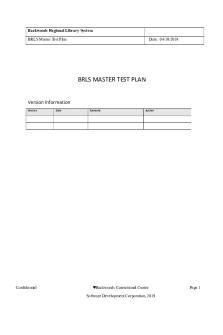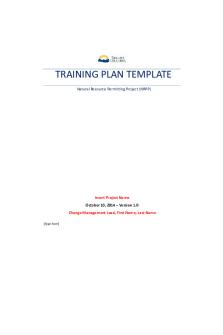BRLS -Master Test Plan Template PDF

| Title | BRLS -Master Test Plan Template |
|---|---|
| Author | pavan ananthula |
| Course | IT Project |
| Institution | Charles Sturt University |
| Pages | 9 |
| File Size | 265.1 KB |
| File Type | |
| Total Downloads | 105 |
| Total Views | 161 |
Summary
qws...
Description
Backwoods Regional Library System BRLS Master Test Plan
Date: 04/10/2019
BRLS MASTER TEST PLAN
Version Information Version
Confidential
Date
Remarks
Author
©Backwoods Correctional Centre Software Development Corporation, 2019
Page 1
Backwoods Regional Library System BRLS Master Test Plan
MANAGEMENT
Date: 04/10/2019
SUMMARY
Project objective To create an error free system with all the required functionalites for the Backwoods Regional Library Systems. The main focus of the project is to create a perfect library managemnt for Backwoods. Test objective and assignment Test objective is to create test plan where every functionality works with multiple different inputs and conditions. Short description of the test approach Results to be realized Result ● Executed fine and finished all the system test.
Document ● ST Test report
Delivery date 04-10-2019
● Executed fine and finished all the system test.
● UAT Test report
04-10-2019
● Executed fine and finished all the system test.
● End report Testing
04-10-2019
Qualitative objectives Every test level needs to completed perfectly on time by using different ouputs and by using all functanalities.
Confidential
©Backwoods Correctional Centre Software Development Corporation, 2019
Page 2
Backwoods Regional Library System BRLS Master Test Plan
Date: 04/10/2019
Table of Contents 1
Introduction
4
1.1
Project and project objective
4
1.2
Objective of the master test plan
4
2
Documentation
5
2.1
Basis for the master test plan
5
2.2
Test basis
5
3
Test strategy
3.1
6
Risk analyses
6
3.1.1
Product risk analyses
6
3.1.2
Technical risk analyses
7
3.2
Risk analyses
7
3.3
Test strategy
7
4
Approach
9
4.1
Test levels
9
4.2
The
9
4.2.1
Goal
9
4.2.2
Short description
9
4.2.3
Entrance and exit criteria for each test level
9
4.2.4
Test environments
9
4.2.5
Defects procedure
9
Confidential
©Backwoods Correctional Centre Software Development Corporation, 2019
Page 3
Backwoods Regional Library System BRLS Master Test Plan
1 1.1
Date: 04/10/2019
Introduction Project and project objective
> This master test plan fits to the project plan Backwoods Regional Library System. The project objective is to create a library mangemnt system, where
1.2
Objective of the master test plan
The objective of the Master Test Plan (MTP) is to inform all who are involved in the test process about the approach, the activities, including the mutual relations and dependencies, and the (end) products to be delivered for the test project Backwoods Regional Library System. The master test plan describes this approach, the activities and (end) products that need further elaboration in the other system test plans. These system test plans need to be abstracted from this master test plan.
Confidential
©Backwoods Correctional Centre Software Development Corporation, 2019
Page 4
Backwoods Regional Library System BRLS Master Test Plan
2
Date: 04/10/2019
Documentation
This chapter describes the documentation used in relation with the master test plan. The described documentation concerns a first inventory and will be elaborated, actualized and detailed at a later stage, during the separate test levels.
2.1
Basis for the master test plan
The following documents are used as basis for this master test plan. Document name
Version
Date
Author
BRLS Vision 201960
0.1
2/02/2019
Stakeholders
BRLS NFR Analysis
0.1
2/02/2019
Stakeholders
2.2
Test basis
The test basis contains the documentation that serves as the basis for the tests that have to be executed. The overview below describes the documentation that is the starting point for testing.
Document name
Version
Date
Author
Unit Testing
0.1
27/10/2019
Kamal Teja
Integration Testing
0.1
03/10/2019
Kamal Teja
System Tests
0.1
04/10/2019
Kamal Teja
Confidential
©Backwoods Correctional Centre Software Development Corporation, 2019
Page 5
Backwoods Regional Library System BRLS Master Test Plan
3
Date: 04/10/2019
Test strategy
The time available for testing is limited; not everything can be tested with equal thoroughness. This means that choices have to be made regarding the depth of testing. Also it is strived to divide test capacity as effective and efficient as possible over the total test project. This principle is the basis of the test strategy. The test strategy is based on risks: a system has to function in practice to an extent that no unacceptable risks for the organization arise from it. If the delivery of a system brings along many risks, thorough testing needs to be put in place; the opposite of the spectrum is also true: 'no risk, no test'. The first step in determining the test strategy is the execution of a product risk analyses. This is elaborated in §3.1. The test strategy is subsequently based on the results of the risk analyses. The test strategy lays down what, how and when (in which test level) is being tested and is focused on finding the most important defects as early as possible for the lowest costs. This can be summarized as testing with an optimal use of the available capacity and time. The test strategy is described in §3.3.
3.1
Risk analyses
3.1.1
Product risk analyses
The product risks are determined in cooperation with the client and the other parties involved. Product risks are those risks associated with the final product failing to meet functional requirements and required system quality characteristics (NFRs) This product risk analyses (PRA) is comprised of two steps: ● Make an inventory of the risks that are of interest ● Classify the risks. Product Risk
Description
Characteristic
>
Classification
The extent of the risk (the risk class) is dependent on the chance of failure (how big the chance is that it goes wrong?) and it depends on the damage for the organization if it actually occurs.
Confidential
©Backwoods Correctional Centre Software Development Corporation, 2019
Page 6
Backwoods Regional Library System BRLS Master Test Plan
3.1.2
Date: 04/10/2019
Technical risk analyses
Technical risks are determined in cooperation with the analyst/designers and programmers involved. Technical risks are development risks associated with failing to create a system that behaves according to specifications derived from requirements. (I.E. those aspects of development that pose particular challenges.) This technical risk analyses (TRA) is comprised of two steps: ● Make an inventory of the risks that are of interest ● Classify the risks. Technical risk
Description
Characteristic
>
3.2
Risk analyses
3.3
Test strategy
For each risk from the product and technical risk analysis the risk class dwtwermines the thoroughness of the test. Risk class A is the highest risk class and C the lowest. The test strategy is subsequently focused on covering the risks with the highest risk class as early as possible in the test project.
>
Risk Functionality
Confidential
RC
Unit
Integration
ST
FAT
UAT
A/B/C
©Backwoods Correctional Centre Software Development Corporation, 2019
Page 7
Backwoods Regional Library System BRLS Master Test Plan
Date: 04/10/2019
- part 1 - part 2 - total User-friendliness Performance Security Suitability
Legend for the table above: RC SR Unit Integration ST FAT UAT ⬤ ⬤⬤ ⬤⬤⬤ S I
Confidential
Risk class (from product and technical risk analysis, where A=high risk, B=average risk, C=low risk) Static Review of the various intermediary products (requirements, functional design, technical design) Unit test and Unit integration test Integration tests (low level (L), high level(H)) System test (functional scenario testing (F), system quality scenario testing (S)) Functional acceptance test (alpha stage UAT) User acceptance test (Beta stage UAT) Limited thoroughness of the dynamic test Medium thoroughness of the dynamic test High thoroughness of the dynamic test Static testing (checking and examining the products without executing the software Implicit testing (including in another test type without creating specifically designed test cases If a cell is blank, it means that the relevant test or evaluation level does not have to be concerned with the characteristic
©Backwoods Correctional Centre Software Development Corporation, 2019
Page 8
Backwoods Regional Library System BRLS Master Test Plan
4
Date: 04/10/2019
Approach
>
4.1
Test levels
> For this MTP the following test levels are acknowledged: Test level
Goal
4.2
The
4.2.1
Goal
>
4.2.2
Short description
4.2.3
Entrance and exit criteria for each test level
4.2.4
Test environments...
Similar Free PDFs

BRLS -Master Test Plan Template
- 9 Pages

Master Thesis Outline Template
- 1 Pages

Quality Improvement Plan template
- 41 Pages

Care Plan Template
- 5 Pages

A4 Presentation Plan Template
- 5 Pages

Coe lesson plan template
- 5 Pages

Activity Plan Template
- 10 Pages

Startup Business Plan Template
- 38 Pages

Business Model PLAN Template
- 14 Pages

5e lesson plan template
- 6 Pages

Plan-Analysis-Template
- 6 Pages

Presentation Plan Template
- 4 Pages

Nrs training plan template
- 15 Pages

Marketing Plan Template
- 11 Pages

Wgu lesson plan template
- 3 Pages
Popular Institutions
- Tinajero National High School - Annex
- Politeknik Caltex Riau
- Yokohama City University
- SGT University
- University of Al-Qadisiyah
- Divine Word College of Vigan
- Techniek College Rotterdam
- Universidade de Santiago
- Universiti Teknologi MARA Cawangan Johor Kampus Pasir Gudang
- Poltekkes Kemenkes Yogyakarta
- Baguio City National High School
- Colegio san marcos
- preparatoria uno
- Centro de Bachillerato Tecnológico Industrial y de Servicios No. 107
- Dalian Maritime University
- Quang Trung Secondary School
- Colegio Tecnológico en Informática
- Corporación Regional de Educación Superior
- Grupo CEDVA
- Dar Al Uloom University
- Centro de Estudios Preuniversitarios de la Universidad Nacional de Ingeniería
- 上智大学
- Aakash International School, Nuna Majara
- San Felipe Neri Catholic School
- Kang Chiao International School - New Taipei City
- Misamis Occidental National High School
- Institución Educativa Escuela Normal Juan Ladrilleros
- Kolehiyo ng Pantukan
- Batanes State College
- Instituto Continental
- Sekolah Menengah Kejuruan Kesehatan Kaltara (Tarakan)
- Colegio de La Inmaculada Concepcion - Cebu
